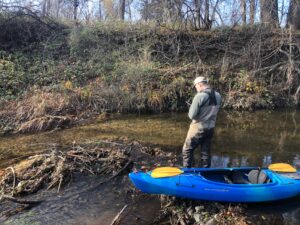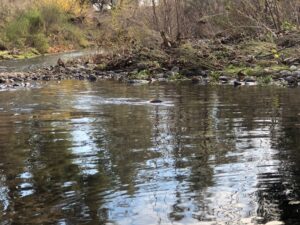A note from Martin Perales, PhD, Napa RCD Environmental Scientist
 Its refreshing to see some water and fish in the rivers! Chinook salmon are staged in the estuary as early as August and wait for the first rains of the season. Our environmental scientists, Martin Perales and Paul Blank, were out on the Napa River in late December conducting Chinook spawner and carcass surveys from their kayaks.
Its refreshing to see some water and fish in the rivers! Chinook salmon are staged in the estuary as early as August and wait for the first rains of the season. Our environmental scientists, Martin Perales and Paul Blank, were out on the Napa River in late December conducting Chinook spawner and carcass surveys from their kayaks.
As they float down the river, they are taking data on the location of any live Chinook salmon, carcasses, and redds (‘salmon nests’). This data, in addition to our juvenile fish monitoring efforts and reports from citizen scientists, keep us informed on how successful the fish are when spawning. Did you know that when a salmon constructs its nest, the geometry of the nest actually encourages river water to percolate through the gravel (hyporheic flow), which provides oxygen to the eggs and young that are buried?
There are many things we can learn from the fish carcasses our scientists encounter. They collect otoliths (fish ear stones) and genetic material from any salmon carcasses they find so that we can better understand the salmon’s life history and determine if they were spawned in the Napa River or not. However, carcasses seem to be very rare in recent years! Our scientists recently witnessed a coyote eating a salmon carcass and noted many partially eaten carcasses. They know the race is on! In the words of our fish specialist, Martin, “The coyotes have nothing to do and all day to do it. Its hard for us to compete!”
Kayak surveys were conducted in late December 2022 (before the January 2023 storms) and at the time it seemed that while it wasn’t a great year as far as amount of water in the river, they expected that a decent number of Chinook were able to spawn. With our recent storms, however, that may have changed. If most of the spawning happened during our first couple smaller storms, these more recent January storms could potentially disrupt redds. It’s a complex ecosystem with many contributing factors, so we won’t really know what’s happening until we start doing juvenile fish sampling with the Rotary Screw Trap this spring.
Surveys were conducted from Bale Ln to Pope St, and from Oakville to Yountville. During the surveys, here’s what Martin and Paul saw:
- 18 redds, 8 of which had adult fish present
- 6 carcasses
- 29 fish
If you see salmon, let us know! Email Martin Perales a photo or video and a location: MartinP@NapaRCD.org



